各位研友想知道2023大连外国语大学考研各专业怎么复习?大纲是什么?请关注各院校2023硕士研究生考研大纲。今天,考研营小编整理了“2023考研大纲:大连外国语大学2023年考研1英语语言文学、外国语言学及应用语言学(英语)专业科目1 综合英语 考试大纲”的相关内容,请持续关注!
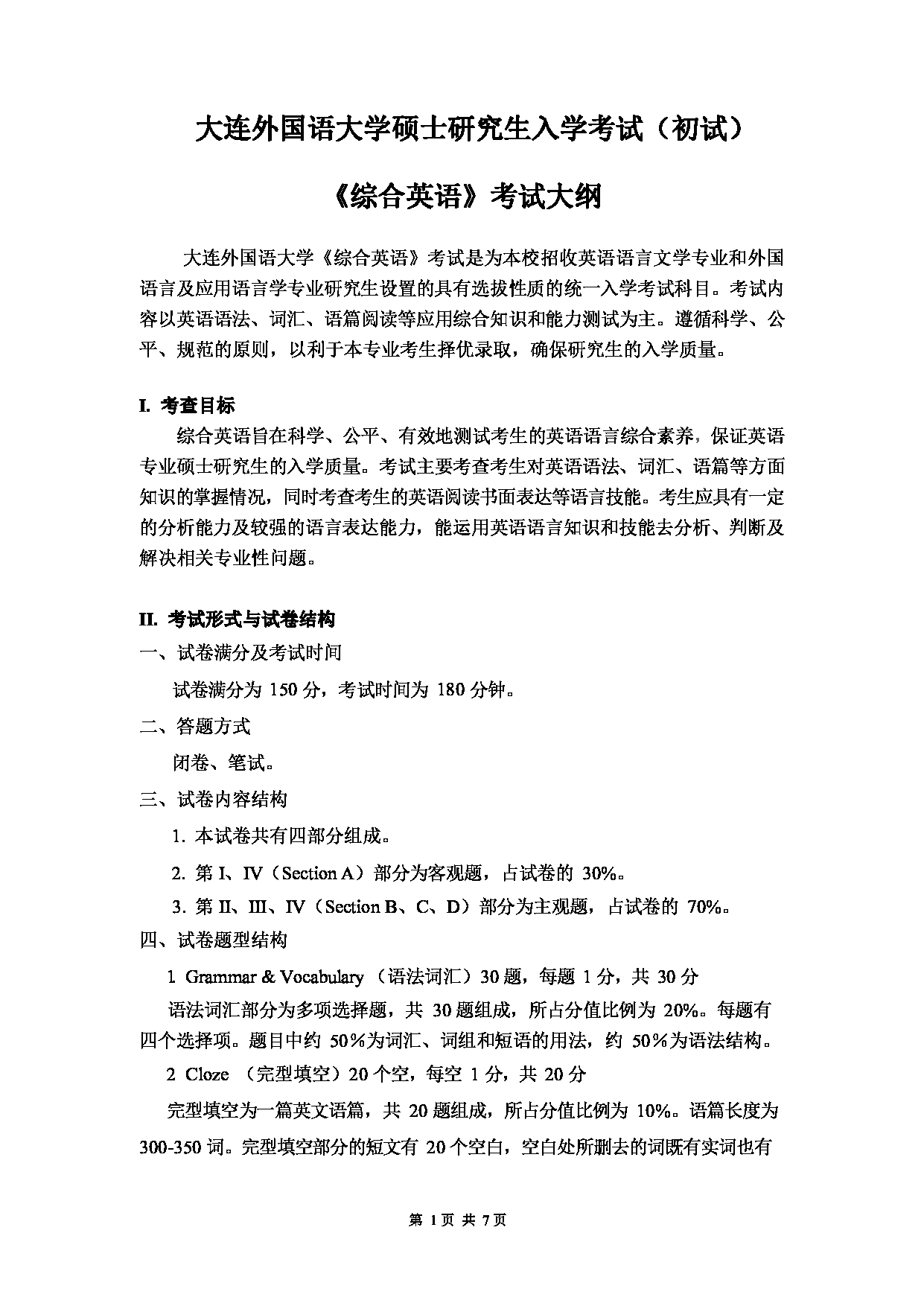

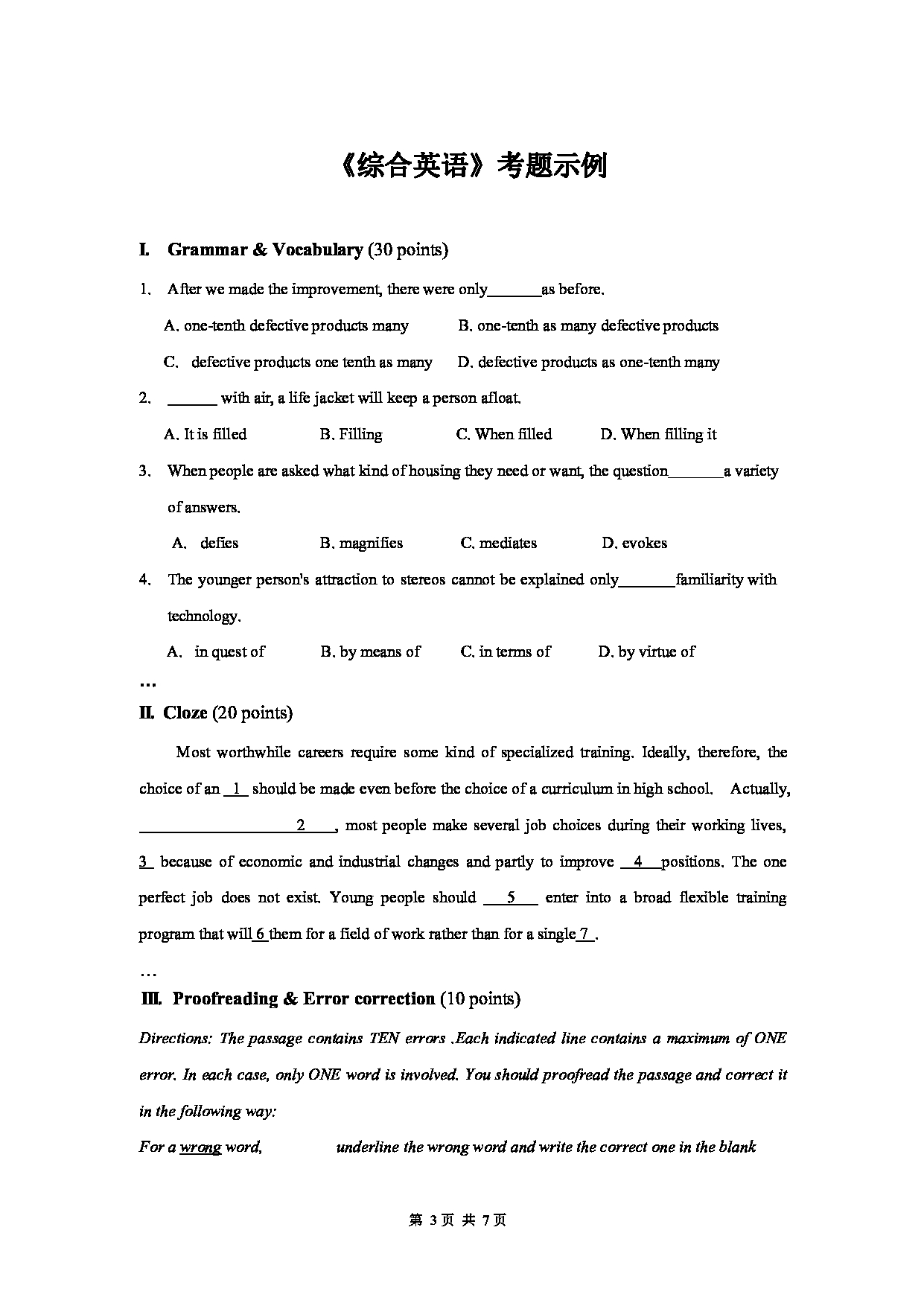
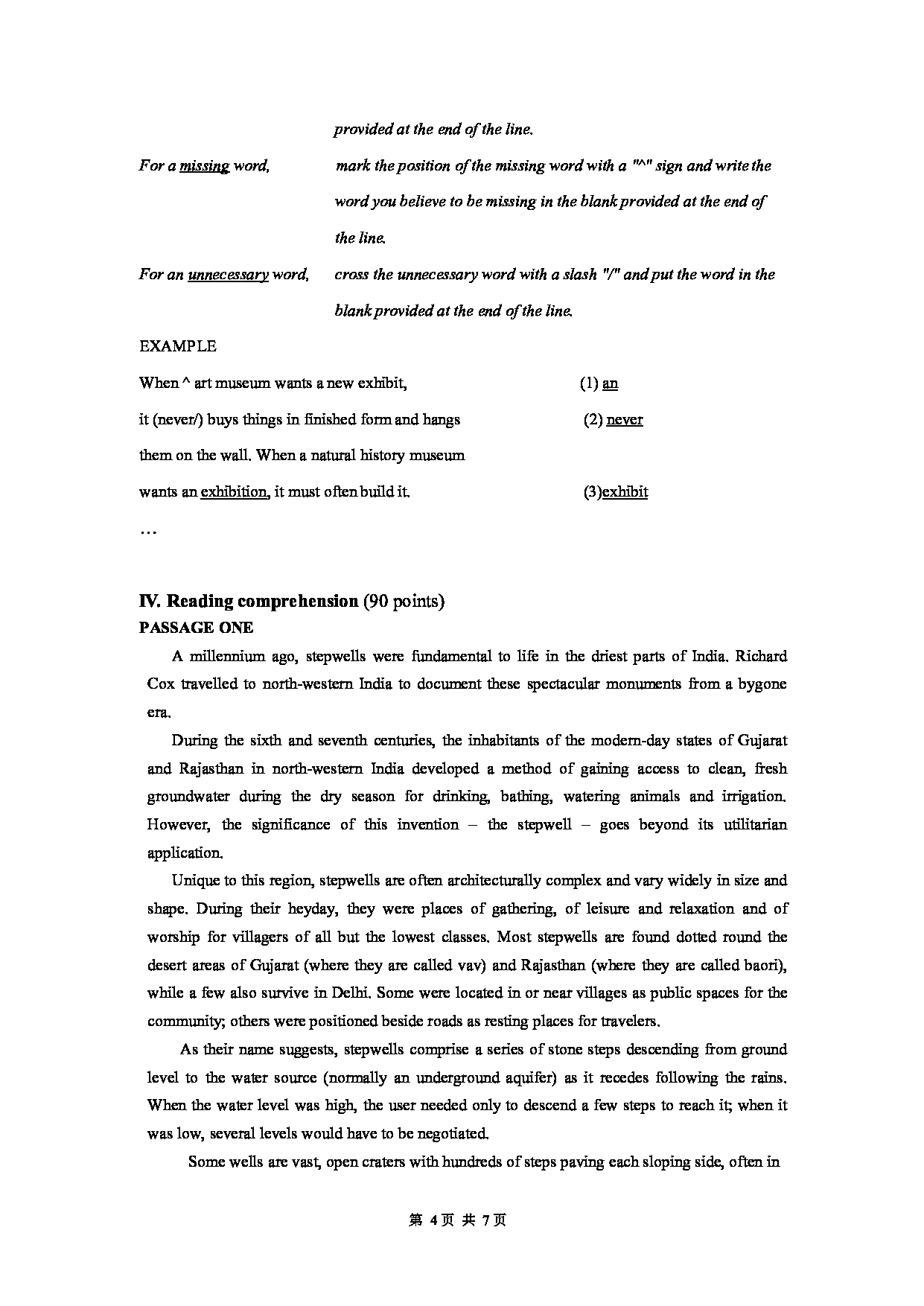
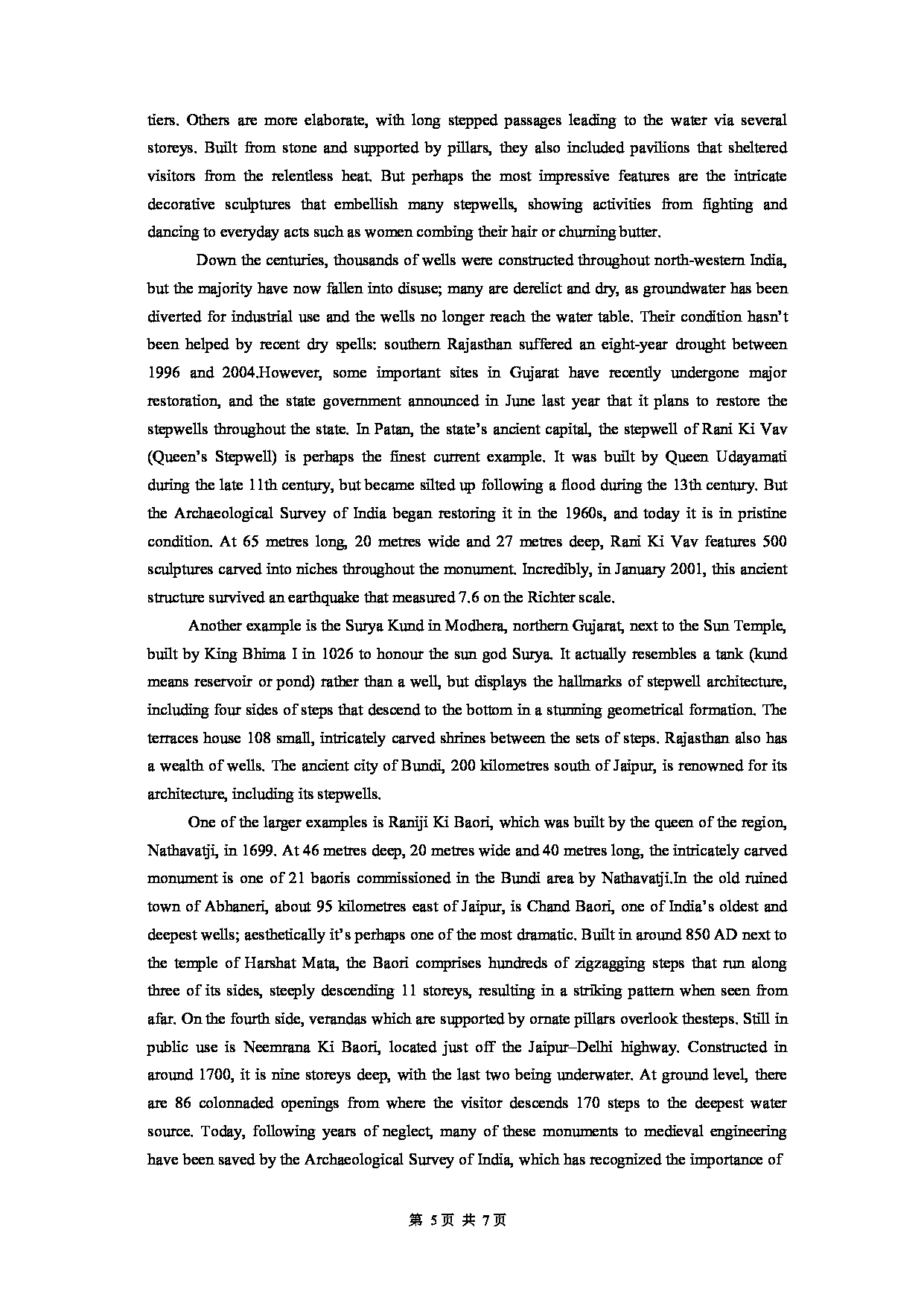
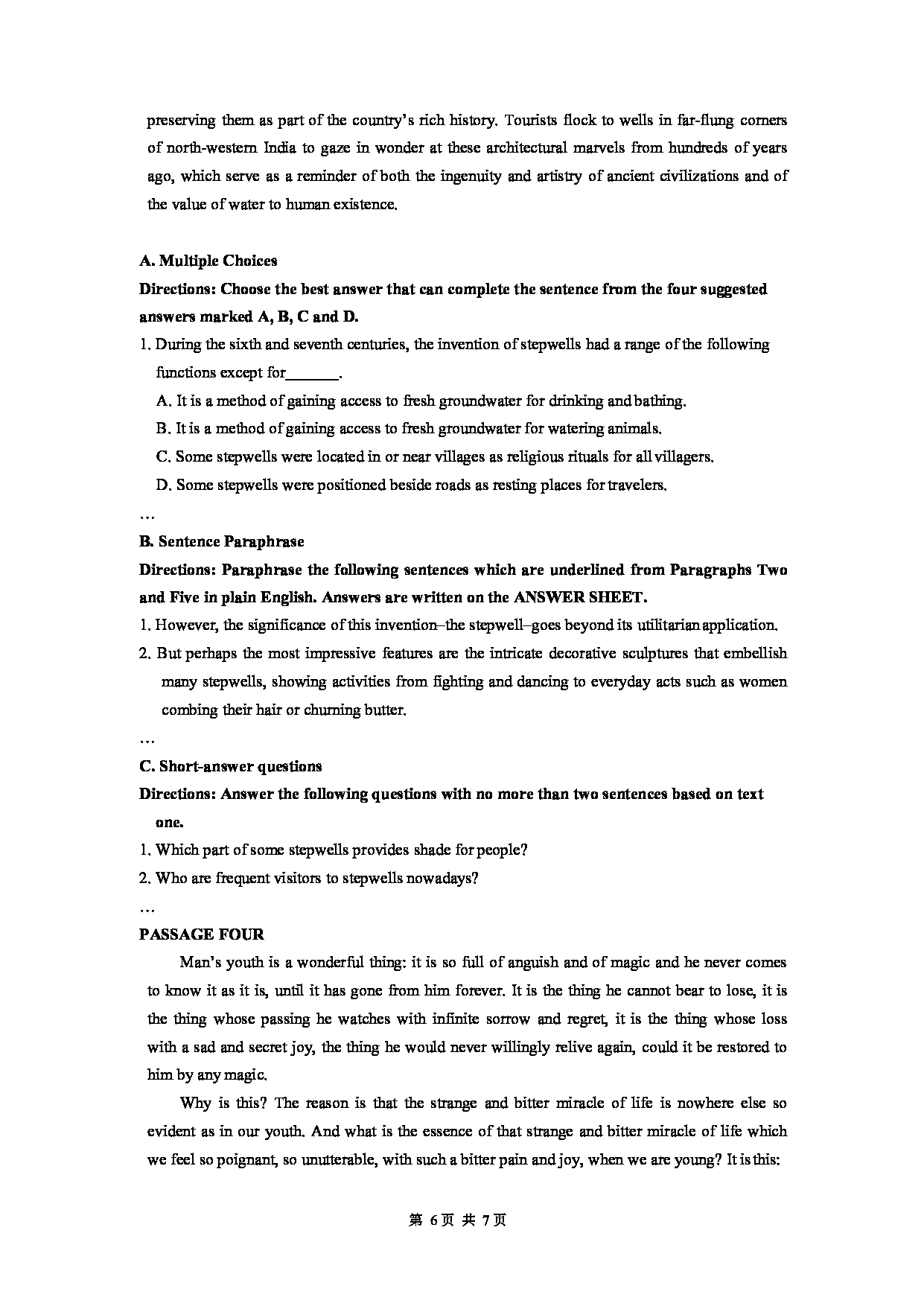
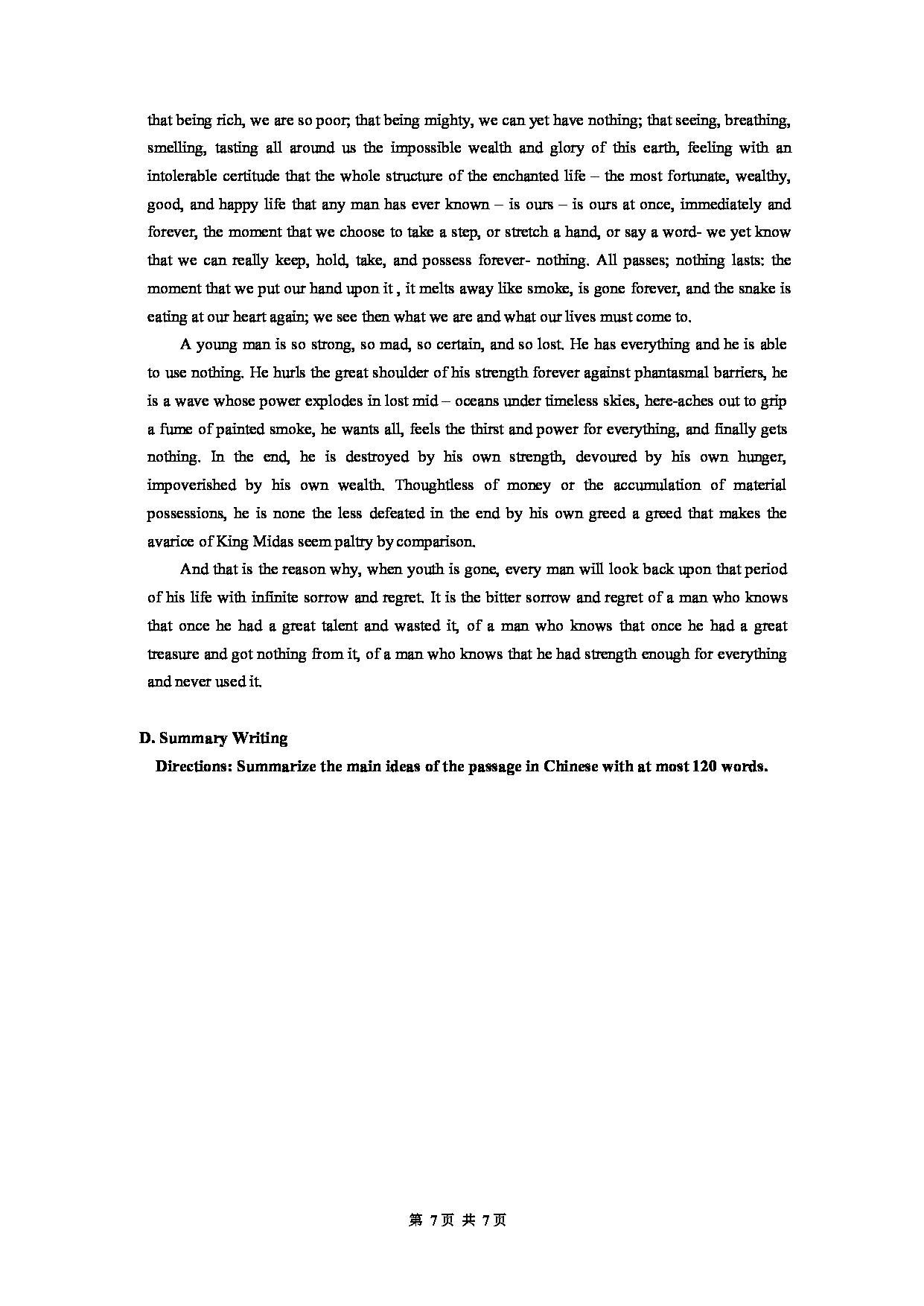
以下为《1英语语言文学、外国语言学及应用语言学(英语)专业科目1 综合英语 考试大纲》文档文字版,内容仅供参考,详情请下载文末附件查看:
第 1页 共 7页
大 连 外 国 语 大 学 硕 士 研 究 生 入 学 考 试 ( 初 试 )
《 综 合 英 语 》 考 试 大 纲
大 连 外 国 语 大 学 《 综 合 英 语 》 考 试 是 为 本 校 招 收 英 语 语 言 文 学 专 业 和 外 国
语 言 及 应 用 语 言 学 专 业 研 究 生 设 置 的 具 有 选 拔 性 质 的 统 一 入 学 考 试 科 目 。 考 试 内
容 以 英 语 语 法 、 词 汇 、 语 篇 阅 读 等 应 用 综 合 知 识 和 能 力 测 试 为 主 。 遵 循 科 学 、 公
平 、 规 范 的 原 则 , 以 利 于 本 专 业 考 生 择 优 录 取 , 确 保 研 究 生 的 入 学 质 量 。
I.
考 查 目 标
综 合 英 语 旨 在 科 学 、 公 平 、 有 效 地 测 试 考 生 的 英 语 语 言 综 合 素 养 , 保 证 英 语
专 业 硕 士 研 究 生 的 入 学 质 量 。 考 试 主 要 考 查 考 生 对 英 语 语 法 、 词 汇 、 语 篇 等 方 面
知 识 的 掌 握 情 况 , 同 时 考 查 考 生 的 英 语 阅 读 书 面 表 达 等 语 言 技 能 。 考 生 应 具 有 一 定
的 分 析 能 力 及 较 强 的 语 言 表 达 能 力 , 能 运 用 英 语 语 言 知 识 和 技 能 去 分 析 、 判 断 及
解 决 相 关 专 业 性 问 题 。
II.
考 试 形 式 与 试 卷 结 构
一 、 试 卷 满 分 及 考 试 时 间
试 卷 满 分 为 150分 , 考 试 时 间 为 180分 钟 。
二 、 答 题 方 式
闭 卷 、 笔 试 。
三 、 试 卷 内 容 结 构
3.第 II、 III、 IV( SectionB、 C、 D) 部 分 为 主 观 题 , 占 试 卷 的 70%。
四 、 试 卷 题 型 结 构
1.Grammar& Vocabulary( 语 法 词 汇 ) 30题 , 每 题 1分 , 共 30分
2.Cloze ( 完 型 填 空 ) 20个 空 , 每 空 1分 , 共 20分
完 型 填 空 为 一 篇 英 文 语 篇 , 共 20题 组 成 , 所 占 分 值 比 例 为 10%。 语 篇 长 度 为
300-350词 。 完 型 填 空 部 分 的 短 文 有 20个 空 白 , 空 白 处 所 删 去 的 词 既 有 实 词 也 有
1. 本试卷共有四部分组成。
2. 第 I、 IV ( Section A )部分为客观题,占试卷的 30% 。
语法词汇部分为多项选择题,共 30 题组成,所占分值比例为 20% 。每题有
四个选择项。题目中约 50 %为词汇、词组和短语的用法,约 50 %为语法结构。
第 2页 共 7页
虚词,每个空白为一题,要求考生根据上下文语境填出所缺词,使短文的意思和 结
构恢复完整。
3. Proofreading & Error correction (短文改错) 10 题,每题 1分,共 10 分
短文改错试题为一篇约 250 词的短文,文中有 10 行标有题号。该 10 行均含
有一个语言错误。要求学生根据 “增添 ”、 “删去 ”或 “改变其中的某一单词或短语 ”
三种方法中的一种,以改正语言错误。
4. Reading Comprehension (阅读理解) 四篇文章,共 90 分
阅读前三篇文章后回答下列题型: (Passage 1-3)
A. Multiple Choice (选择题) 每篇 5题 共 15 题 每题 1分, 共 15 分
B. Sentence Paraphrase ( 句子释义题 ) 每篇 2题 共 6题 每题 5分,共 30 分
C. Short-answerQuestions( 简 答 题 ) 每篇 2题 共 6题 每题 5分 , 共 30分
阅读第四篇文章后进行概要写作: (Passage 4)
D. SummaryW riting( 篇 章 概 述 题 ) 阅 读 第 四 篇 文 章 后 , 用 中 文 写 概 要 共 15分 阅
读理解部分采用单选题、句子释义题、简答题和篇章概述题等四种主、 客
观题型。
III.考试范围
1. 语法词汇:考查考生运用词汇、短语以及基本语法结构的能力。
2. 完型填空:考查考生语法、词汇和语篇等各个层面上的语言理解能力和
语言运用能力。
3. 短文改错:考查考生运用语法、词汇、修辞、逻辑等语言知识识别短文内 的
语病并提出改正方法的能力。
4. 阅读理解:考查考生通过阅读获取有关信息的能力,掌握相关阅读策略和 技
巧的程度以及考查考生阅读包括学术语篇在内的正规语体语篇的能力。选材题 材广
泛,包括社会、文化、文学、语言、人物传记等。体裁多样,包括记叙文、 说明文、
描写文、议论文等。
第 3页 共 7页
《综合英语》考题示例
I. Grammar & Vocabulary (30 points)
1. After we made the improvement, there were only as before.
A. one-tenth defective products many B. one-tenth as many defective products
C. defective products one tenth as many D. defective products as one-tenth many
2. with air, alife jacket will keep aperson afloat.
A. Itisfilled B. Filling C. When filled D. When filling it
3. When people are asked what kind of housing they need or want, the question avariety
of answers.
A. defies B. magnifies C. mediates D. evokes
4. The younger person's attraction to stereos cannot be explained only familiarity with
technology.
A. in quest of B. by means of C. in terms of D. by virtue of
…
II. Cloze (20 points)
Most worthwhile careers require some kind of specialized training. Ideally, therefore, the
choice of an 1 should be made even before the choice of acurriculum in high school. Actually,
2 ,most people make several job choices during their working lives,
3 because of economic and industrial changes and partly to improve 4 positions. The one
perfect job does not exist. Young people should 5 enter into abroad flexible training
program that will 6them for afield of work rather than for asingle 7.
…
III. Proofreading & Error correction (10 points)
Directions: The passage contains TEN errors .Each indicated line contains amaximum of ONE
error. In each case, only ONE word is involved. You should proofread the passage and correct it
in the following way:
For awrong word, underline the wrong word and write the correct one in the blank
第 4页 共 7页
provided at the end of the line.
For amissing word, mark the position of the missing word with a"^" sign and write the
word you believe to be missing in the blank provided at the end of
the line.
For an unnecessary word, cross the unnecessary word with aslash "/" and put the word in the
blank provided at the end of the line.
EXAMPLE
When ^art museum wants anew exhibit, (1) an
it(never/) buys things in finished form and hangs (2) never
them on the wall. When anatural history museum
wants an exhibition ,itmust often build it. (3) exhibit
…
IV. Reading comprehension (90 points)
PASSAGE ONE
A millennium ago, stepwells were fundamental to life in the driest parts of India. Richard
Cox travelled to north-western India to document these spectacular monuments from abygone
era.
During the sixth and seventh centuries, the inhabitants of the modern-day states of Gujarat
and Rajasthan in north-western India developed amethod of gaining access to clean, fresh
groundwater during the dry season for drinking, bathing, watering animals and irrigation.
However, the significance of this invention – the stepwell – goes beyond its utilitarian
application.
Unique to this region, stepwells are often architecturally complex and vary widely in size and
shape. During their heyday, they were places of gathering, of leisure and relaxation and of
worship for villagers of all but the lowest classes. Most stepwells are found dotted round the
desert areas of Gujarat (where they are called vav) and Rajasthan (where they are called baori),
while afew also survive in Delhi. Some were located in or near villages as public spaces for the
community; others were positioned beside roads as resting places for travelers.
As their name suggests, stepwells comprise aseries of stone steps descending from ground
level to the water source (normally an underground aquifer) as it recedes following the rains.
When the water level was high, the user needed only to descend afew steps to reach it; when it
was low, several levels would have to be negotiated.
Some wells are vast, open craters with hundreds of steps paving each sloping side, often in
第 5页 共 7页
tiers. Others are more elaborate, with long stepped passages leading to the water via several
storeys. Built from stone and supported by pillars, they also included pavilions that sheltered
visitors from the relentless heat. But perhaps the most impressive features are the intricate
decorative sculptures that embellish many stepwells, showing activities from fighting and
dancing to everyday acts such as women combing their hair or churning butter.
Down the centuries, thousands of wells were constructed throughout north-western India,
but the majority have now fallen into disuse; many are derelict and dry, as groundwater has been
diverted for industrial use and the wells no longer reach the water table. Their condition hasn ’t
been helped by recent dry spells: southern Rajasthan suffered an eight-year drought between
1996 and 2004.However, some important sites in Gujarat have recently undergone major
restoration, and the state government announced in June last year that it plans to restore the
stepwells throughout the state. In Patan, the state ’sancient capital, the stepwell of Rani Ki Vav
(Queen ’sStepwell) is perhaps the finest current example. It was built by Queen Udayamati
during the late 11th century, but became silted up following aflood during the 13th century. But
the Archaeological Survey of India began restoring it in the 1960s, and today itis in pristine
condition. At 65 metres long, 20 metres wide and 27 metres deep, Rani Ki Vav features 500
sculptures carved into niches throughout the monument. Incredibly, in January 2001, this ancient
structure survived an earthquake that measured 7.6 on the Richter scale.
Another example isthe Surya Kund in Modhera, northern Gujarat, next to the Sun Temple,
built by King Bhima Iin 1026 to honour the sun god Surya. Itactually resembles atank (kund
means reservoir or pond) rather than awell, but displays the hallmarks of stepwell architecture,
including four sides of steps that descend to the bottom in astunning geometrical formation. The
terraces house 108 small, intricately carved shrines between the sets of steps. Rajasthan also has
awealth of wells. The ancient city of Bundi, 200 kilometres south of Jaipur, is renowned for its
architecture, including its stepwells.
One of the larger examples is Raniji Ki Baori, which was built by the queen of the region,
Nathavatji, in 1699. At 46 metres deep, 20 metres wide and 40 metres long, the intricately carved
monument is one of 21 baoris commissioned in the Bundi area by Nathavatji.In the old ruined
town of Abhaneri, about 95 kilometres east of Jaipur, is Chand Baori, one of India ’soldest and
deepest wells; aesthetically it’sperhaps one of the most dramatic. Built in around 850 AD next to
the temple of Harshat Mata, the Baori comprises hundreds of zigzagging steps that run along
three of its sides, steeply descending 11 storeys, resulting in astriking pattern when seen from
afar. On the fourth side, verandas which are supported by ornate pillars overlook thesteps. Still in
public use is Neemrana Ki Baori, located just off the Jaipur –Delhi highway. Constructed in
around 1700, itis nine storeys deep, with the last two being underwater. At ground level, there
are 86 colonnaded openings from where the visitor descends 170 steps to the deepest water
source. Today, following years of neglect, many of these monuments to medieval engineering
have been saved by the Archaeological Survey of India, which has recognized the importance of
第 6页 共 7页
preserving them as part of the country ’srich history. Tourists flock to wells in far-flung corners
of north-western India to gaze in wonder at these architectural marvels from hundreds of years
ago, which serve as areminder of both the ingenuity and artistry of ancient civilizations and of
the value of water to human existence.
A. Multiple Choices
Directions: Choose the best answer that can complete the sentence from the four suggested
answers marked A, B, C and D.
1. During the sixth and seventh centuries, the invention of stepwells had arange of the following
functions except for .
A. Itisamethod of gaining access to fresh groundwater for drinking and bathing.
B. Itisamethod of gaining access to fresh groundwater for watering animals.
C. Some stepwells were located in or near villages as religious rituals for all villagers.
D. Some stepwells were positioned beside roads as resting places for travelers.
…
B. Sentence Paraphrase
Directions: Paraphrase the following sentences which are underlined from Paragraphs Two
and Five in plain English. Answers are written on the ANSWER SHEET.
1. However, the significance of this invention –the stepwell –goes beyond its utilitarian application.
2. But perhaps the most impressive features are the intricate decorative sculptures that embellish
many stepwells, showing activities from fighting and dancing to everyday acts such as women
combing their hair or churning butter.
…
C. Short-answer questions
Directions: Answer the following questions with no more than two sentences based on text
one.
1. Which part of some stepwells provides shade for people?
2. Who are frequent visitors to stepwells nowadays?
…
PASSAGE FOUR
Man ’syouth is awonderful thing: itis so full of anguish and of magic and he never comes
to know itas itis, until ithas gone from him forever. Itis the thing he cannot bear to lose, itis
the thing whose passing he watches with infinite sorrow and regret, itis the thing whose loss
with asad and secret joy, the thing he would never willingly relive again, could itbe restored to
him by any magic.
Why is this? The reason is that the strange and bitter miracle of life is nowhere else so
evident as in our youth. And what is the essence of that strange and bitter miracle of life which
we feel so poignant, so unutterable, with such abitter pain and joy, when we are young? Itisthis:
第 7页 共 7页
that being rich, we are so poor; that being mighty, we can yet have nothing; that seeing, breathing,
smelling, tasting all around us the impossible wealth and glory of this earth, feeling with an
intolerable certitude that the whole structure of the enchanted life –the most fortunate, wealthy,
good, and happy life that any man has ever known –is ours –is ours at once, immediately and
forever, the moment that we choose to take astep, or stretch ahand, or say aword- we yet know
that we can really keep, hold, take, and possess forever- nothing. All passes; nothing lasts: the
moment that we put our hand upon it,itmelts away like smoke, isgone forever, and the snake is
eating at our heart again; we see then what we are and what our lives must come to.
A young man is so strong, so mad, so certain, and so lost. He has everything and he is able
to use nothing. He hurls the great shoulder of his strength forever against phantasmal barriers, he
isawave whose power explodes in lost mid –oceans under timeless skies, here-aches out to grip
afume of painted smoke, he wants all, feels the thirst and power for everything, and finally gets
nothing. In the end, he is destroyed by his own strength, devoured by his own hunger,
impoverished by his own wealth. Thoughtless of money or the accumulation of material
possessions, he is none the less defeated in the end by his own greed agreed that makes the
avarice of King Midas seem paltry by comparison.
And that is the reason why, when youth is gone, every man will look back upon that period
of his life with infinite sorrow and regret. Itis the bitter sorrow and regret of aman who knows
that once he had agreat talent and wasted it, of aman who knows that once he had agreat
treasure and got nothing from it, of aman who knows that he had strength enough for everything
and never used it.
D. Summary Writing
Directions: Summarize the main ideas of the passage in Chinese with at most 120 words.
以上就是小编整理的“2023考研大纲:大连外国语大学2023年考研1英语语言文学、外国语言学及应用语言学(英语)专业科目1 综合英语 考试大纲”的全部内容,更多关于大连外国语大学2023年考研大纲的信息,尽在“考研大纲”栏目,希望对大家有所帮助!
附件: 大连外国语大学2023年考研1英语语言文学、外国语言学及应用语言学(英语)专业科目1 综合英语 考试大纲.pdf



